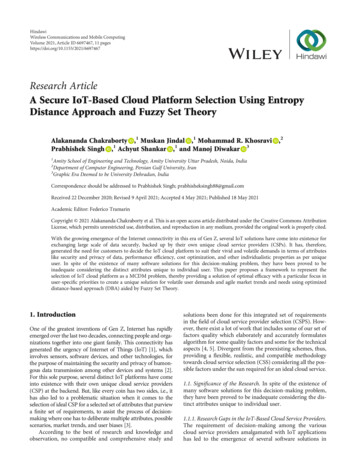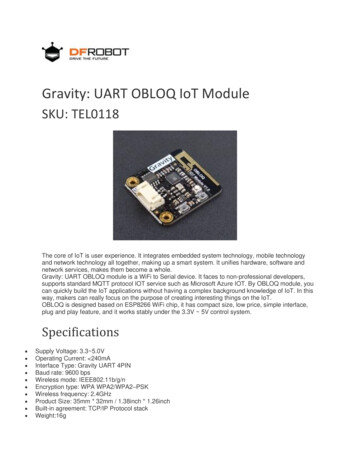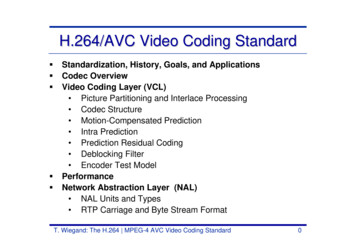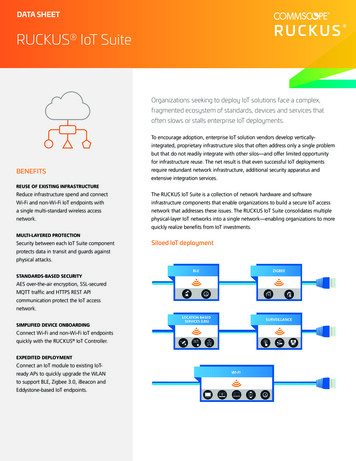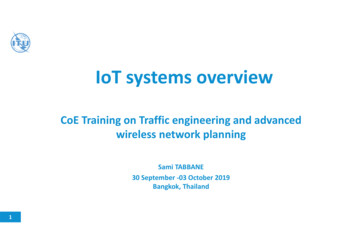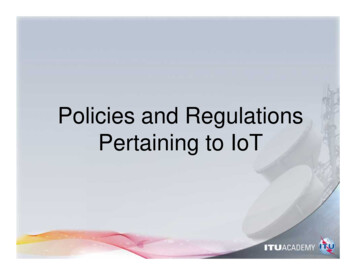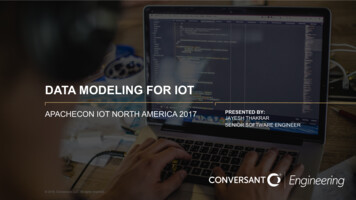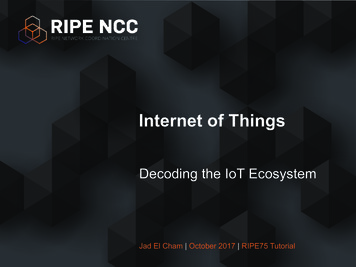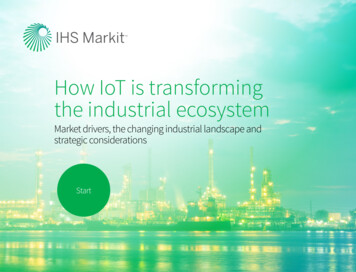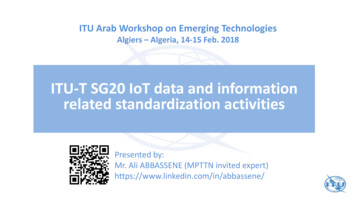
Transcription
ITU Arab Workshop on Emerging TechnologiesAlgiers – Algeria, 14-15 Feb. 2018ITU-T SG20 IoT data and informationrelated standardization activitiesPresented by:Mr. Ali ABBASSENE (MPTTN invited expert)https://www.linkedin.com/in/abbassene/
Agenda SG20 in a nutshell Main SG20’s data-related IoT Recommendations– IoT Semantics requirements (Approved)– IoT Big Data Requirements (Approved)– Things Description Requirements (Ongoing)– Business Process Requirements (NWI) Some interesting documents from FG-DPM What about ML & AI ?2
SG20 IN A NUTSHELL3
ITU-T Study Group 20: Internet of things (IoT) and smart cities andcommunities (SC&C)SG20 structure and mandate“IoT and Smart Cities & Communities”Responsible for studiesrelating to IoT and itsapplications, and smart citiesand communities (SC&C).It includes studies relating toBig data aspects of IoT andSC&C, e-services and smartservices for SC&CLead study group onInternet of things(IoT) and itsapplicationsSmart Cities andCommunities(SC&C), includingits e-servicesand smart servicesLast SG20 meeting: 4-15 September 2017Last RGM & WP1/20 meeting: 15-24 Jan 2018Next SG20 meeting : 6-16 May 2018, Cairo2 Working Parties25 October – 3November 2016IoT identification7 Questions4 Regional GroupsRes 98 Enhancing the standardization ofInternet of things and Smart Cities andCommunities for global developmentOver 100 International experts4
MAIN SG20’S DATA-RELATED IOTRECOMMENDATIONS5
SG20outcomesMain results (Oct. 15 – Jan. 18)17 New Recommendations approved ITU-T Y.4101 "Common requirements and capabilitiesof a gateway for Internet of Things applications“ITU-T Y.4116 "Requirements of transportation safetyservice including use cases and service scenarios"ITU-T Y.4117 "Requirements and capabilities ofInternet of Things for support of wearable devicesand related services“ITU-T Y.4455 "Reference architecture for IoT networkservice capability exposure“ITU-T Y.4805 "Identifier service requirements for theinteroperability of Smart City applications“ITU-T Y.4806 " Security capabilities supporting safetyof the Internet of Things"ITU-T Y.4113 “Requirements of the network for theInternet of Things”ITU-T Y.4451 “Framework of constrained devicenetworking in the IoT environments”ITU-T Y.4452 “Functional framework of Web ofObjects”ITU-T Y.4453 “Adaptive software framework for IoTdevices”ITU-T Y.4553 “Requirements of smartphone as sinknode for IoT applications and services”ITU-T Y.4702 “Common requirements and capabilities”ITU-T Y.4114 “Specific requirements and capabilitiesof the IoT for Big Data”ITU-T Y.4115 “Reference architecture for IoT devicecapability exposure“ITU-T Y.4500.1 “oneM2M- Functional Architecture”ITU-T Y.4200 “Requirements for interoperability ofsmart city platforms”ITU-T Y.4201 “High-level requirements and referenceframework of smart city platform”10 New Supplements agreed ITU-T Y.Supp.45 to ITU-T Y.4000 series "An overview ofsmart cities and communities and the role ofinformation and communication se cases of User-Centric work Space (UCS) ServiceITU-TY.Supp.34toITU-TY.4000series"Smart Sustainable Cities - Setting the stage forstakeholders' engagement"ITU-TY.Supp.33toITU-TY.4000series"Smart Sustainable Cities - Master plan"ITU-TY.Supp.32toITU-TY.4000series"Smart sustainable cities - a guide for city leaders“ITU-TY.Supp.31toITU-TY.4550series"Smart Sustainable Cities - Intelligent series”Integrated management for smart sustainable i-service infrastructure for smart sustainable citiesin new-development iew of smart sustainable cities s“Setting the framework for an ICT architecture of asmart sustainable city”.2 Draft new Recommendations determined6 ITU-T Y.4454 “Platform Interoperability for Smart quirements”
SG20outcomesMain results (Oct. 15 – Jan. 18)6 oneM2M Specifications translated into newTechnical Papers15 oneM2M Specifications translated into newRecommendations Y.4500.1 (ex Y.oneM2M.ARC) "oneM2M- FunctionalArchitecture"Y.4500.4 (ex Y.oneM2M.SLCP) "oneM2M Service LayerCore Protocol Specification"Y.4500.6 (ex Y.oneM2M.DM.BBF) "oneM2M Managementenablement (BBF)"Y.4500.15 (ex Y.oneM2M.TF) "oneM2M- Testingframework"Y.4500.10 (ex Y.oneM2M.PB.MQTT) "oneM2M- MQTTProtocol M M2MInteroperability Testing"Y.4500.22 (ex Y.oneM2M.FDC) "oneM2M- Field eM2MManagement enablement (OMA)"Y.4500.11 (ex Y.oneM2M.CT) "oneM2M- CommonTerminology"Y.4500.9 (ex Y.oneM2M.PB.HTTP) "oneM2M- HTTPProtocol Binding"Y.4500.8 (ex Y.oneM2M.PB.CoAP) "oneM2M- CoAPProtocol iances Information Model and Mapping"Y.4500.12 (ex Y.oneM2M.BO) "oneM2M Base Ontology“Y.4500.20 (ex Y.oneM2M.PB.WebSocket) “oneM2MWebSocket Protocol Binding” Y.oneM2M.Ind.DE“oneM2MIndustrial DomainEnablement"Y.oneM2M.UCC “oneM2M Use Case eveloper guide: Light control example using HTTPbinding"Y.oneM2M.DG.CoAP “oneM2M Developer Guide ofCoAP binding and long polling for temperaturemonitoring"Y.oneM2M.DG.DM “oneM2M- Developer guide ofdevice management"Y.oneM2M.DG.SEM "oneM2M-Developer Guide ofImplementing semantics"SG13 transferred Recommendations Y.4111/Y2076 (ex Y.IoT-semantic-reqt) "Semanticsbased requirements and framework of the IoT"SG20 Ongoing Work Items gs description in the Internet of Things" (inprogress)Y.IoT-BPM-reqts-caps "Specific Requirements andCapabilities of the Internet of Things for BusinessProcess Management" (NWI)
Q2/20 data & information related work items Published Recommendations– Approved Y.4111 “Semantics based requirements and framework of theInternet of things”– Approved Y.4114 “Specific requirements and capabilities of the IoT forBig Data” Ongoing work items– Y.IoT-things-description-reqts “Requirements of things description in theInternet of Things”– Y.IoT-BPM-reqts-caps “Specific Requirements and Capabilities of theInternet of Things for Business Process Management” (NWI)– Further activities TBD8
IOT SEMANTICS REQUIREMENTS9
IoT Semantics requirementsFew details on approved Y.4111 ”Semantics based requirements and frameworkof the Internet of things”Structure of the document:- introduction to semantic technologies for the IoT;- semantics based use cases for IoT actors;- semantics based requirements of the IoT;- semantics based capability framework of the IoT.- Appendix I : IoT semantics applications scenariosEssential requirements of the IoT infrastructure for data and services: interoperability, scalability, discovery, consistency, reusability and composability, analytics andreasoning for actionable intelligence, automatic operationsSome factors driving these requirements: number of interconnected things, variety of devices, types ofcollected data, number and types of servicesThe semantics based approaches reveal outstanding features to support these requirements,increasing the level of interoperability of IoT systems10
IoT Semantics requirementsFew details on approved Y.4111 ”Semantics based requirements and frameworkof the Internet of things”Semanticsbasedscenariosof the IoT(examples)Global view ofthe IoTsemanticsbasedcapabilityframework
IOT BIG DATA REQUIREMENTS12
IoT Big Data RequirementsFew details on approved Y.4114 “Specific requirements and capabilities of theIoT for Big Data”Structure of the document:- Overview of Big Data in the IoT- Requirements of the IoT for Big Data- Capabilities of the IoT for Big DataIt complements the developments on common requirements and functional framework of the IoT[ITU-T Y.4100] (common reqts) [ITU-T Y.4401](fct fx) in terms of the specific requirements andcapabilities that the IoT is expected to support in order to address the challenges related to Big DataA basis for further standardization work (e.g. functional entities, APIs and protocols) concerning BigData in the IoT13
IoT Big Data RequirementsFew details on approved Y.4114 “Specific requirements and capabilities of theIoT for Big Data”IoT DataproviderIoT DataconsumerDevice providerDevice providerNetwork a injectedcollectedfromfrom thingsexternalresourcesNetwork providerIoT Data carrierPlatformproviderNetwork providerApplicationproviderIoT dataIoT dataIoT dataIoT dataIoT DataapplicationproviderIoT DataframeworkproviderApplicationproviderNetwork providerPlatformproviderApplicationcustomerDevice provider14Network providerMappings fromIoT businessroles to IoTdata roles
IoT Big Data RequirementsFew details on approved Y.4114 “Specific requirements and capabilities of theIoT for Big Data”Abstract representation of the various IoT data operations and related data flows(considering that the diverse set of concrete IoT deployments do not imply a unique logicalsequencing of the various IoT data operations)Data tavisualizationDataTransferDatastorage15IoT data operations mapped inthe document on layers of IoTReference Model
IoT Big Data RequirementsFew details on approved Y.4114 “Specific requirements and capabilities of theIoT for Big Data”IoT data operations\IoTcomponentsData CollectionData Pre-processingData StorageData AnalysisData TransferData QueryData visualization/applicationDeviceGateway Network IoTPlatform IoT ApplicationServer Key IoT data operations performed by thedifferent IoT components16Capabilities of the IoT for Big Data :-Big Data collectionBig Data pre-processingBig Data storageBig Data transferBig Data time synchronizationBig Data analysisBig Data queryBig Data visualizationBig Data security and privacy protection
THINGS DESCRIPTION REQUIREMENTS17
Things Description RequirementsFew details on ongoing draft Rec. Y.IoT-things-description-reqts “Requirementsof things description in the Internet of Things”Rationale for the study item: many types of things can be integrated together in an IoT system. Because of theheterogeneity of these different things, their description is provided from different angles via different information models.So, normally, things descriptions are domain-dependent. The identification of common requirements for things descriptionin the IoT aims to enable the usage of a diversity of (existing and under development) metadata and ontologies.Work plan of the study item: based on ITU-T Y.4000 (IoT overview), considering related requirements of IoT, as well asrelated work of SDOs, incl. oneM2M and W3C, requirements of things description from a global view point are investigated.The requirements focus on the aspects which can help bridging the things description efforts between ITU-T and other SDOs.The requirements are expected to be collected from a variety of stakeholders (from vendors to providers andadministrations) of the international community.Current structure of the document:- Introduction of things description in IoT (overview, relationships, description types)- Requirements of things description in IoT (high level requirements, information elements)18
Things Description RequirementsFew details on ongoing draft Rec. Y.IoT-things-description-reqts “Requirementsof things description in the Internet of Things”19
Things Description RequirementsFew details on ongoing draft Rec. Y.IoT-things-description-reqts “Requirementsof things description in the Internet of Things”20
Things Description RequirementsFew details on ongoing draft Rec. Y.IoT-things-description-reqts “Requirementsof things description in the Internet of Things”21
BPM REQUIREMENTS22
Business Process RequirementsFew details on ongoing draft Rec. Y.IoT-BPM-reqts-caps “Specific Requirementsand Capabilities of the Internet of Things for Business Process Management”Rationale for the study item: Currently some BPM applications make use of IoT to access, real time sensed data comingfrom physical world instead of DBs, to automatically and physically enact business processes, via actuators, to reduce latencyof decision making. IoT can be enhanced to support more efficiently BPM applications, and to leverage advanced andcomplex BPM scenarios.Work plan of the study item: identifies specific requirements and capabilities of the IoT for supporting BPM, and buildson common requirements of the IoT [ITU-T Y.4100] and on functional framework and capabilities of the IoT [ITU-T Y.4401], interms of the specific reqts & caps that the IoT is expected to provide to support more efficiently BPM applications, and toleverage advanced and complex BPM scenariosNOTE – In the other way, BPM can also be beneficial for IoT applications, but this is not considered in the scope of thisrecommendation.Current structure of the document:–––Overview of BPM in the context of IoTRequirements of the IoT for BPMCapabilities of the IoT for BPM23
SOME INTERESTING DOCUMENTS FROM FG-DPM24
Focus Group on Data Processing and Management to support IoT and SmartCities & Communities (FG-DPM)Key priorities:5 Working GroupsWG1 - Use Cases,Requirements andApplications/ServicesWG2 - DPMFramework,Architectures andCore ComponentsWG3 - Datasharing,Interoperabilityand BlockchainWG4 - Security,Privacy and TrustincludingGovernanceFirst meeting: Geneva, 17-19 Jul. 2017Second meeting: Geneva, Oct. 2017Third meeting : Brussels, 20-23 Feb. 20181st ITU Workshop on Data Processing and Management for IoT andSmart Cities & Communities (Brussels, Belgium, 19 Feb. 2018) 25WG5 - DataEconomy,commercializationand monetizationTo propose mechanisms ,frameworks andguidelines for supportingthe security, privacy andinteroperability ofdatasets and datamanagement systemswithin the IoT and smartcity domain.
FG-DPM: Some interesting documents ! D1.1 UCs Analysis and General Reqts for DPM– Apx.II.1. UCs in the Healthcare : EMR, healthcare processes, – Apx.II.2. UCs SynchroniCity : DMP example architectures– Apx.II.3. Digital Interface to urban processes for registered legal entities (SC&C as big cyber-physical system): actors, urban processes D2.1 DPM Fx for Data-driven IoT/SC&C– Draft Technical Report on “DPM Fx for Data-driven IoT/SC&C” : key concepts, value chain, ref archs D2.3 Data Modeling and Formats Specification for DPM– Draft Technical Report on “Data format in IoT and smart city”– Draft Technical Report on “Web based Microdata formats for IoT and Smart city”– Draft Technical Report on “Metadata format in IoT and smart city” D3.2 Techincal Enablers for Open Data Platform– Draft technical specifications on “SensorThings API – Sensing, cross-domain IoT data model and RESTful API”– Draft Technical Report on “Framework to support data interoperability in IoT environments” NIST Big Data Interoperability Framework (NBDIF), EUROCITIES (Data WG), oneM2M relashionship to DPM,Proposed TR on DPM S/M Smart Cities (U4SSC WG1 : setting fx), Context info mgnt (ETSI), Proposed TR on26Fx of overall design of opendata (SESIAD, Spain), etc.
WHAT ABOUT ML & AI ?27
Machine Learning & Artificial Intelligence Focus Group on Machine Learning for Future Networks including 5G (set by SG13at its Nov 2017 meeting) :– 1st meeting: 29 January - 1 February 2018 (Geneva) & Workshop on Machine Learningfor 5G and beyond, 29 January 2018.– 2nd meeting: 24, 26 - 27 April 2018 (Xi’an, China) & Workshop on Impact of AI on ICTInfrastructures, 25 April 2018. FG-ML5G structure :– WG1 "Use cases, services and requirements"– WG2 "Data formats & ML technologies"– WG3 "ML-aware network architecture"FG on Why not a FG-DPM/WG on ML&AI ? Or why not a Focus Group on ML&AI for IoT/SC&C ?284&
http://itu.int/go/tsg2029Ali ABBASSENE (Arab ET Workshop Algiers, 14-15 Feb. 18)
ITU-T SG20 IoT data and information . ITU-T Y.4500.1 "oneM2M- Functional Architecture . Y.oneM2M.Ind.DE "oneM2M Industrial Domain Enablement" Y.oneM2M.UCC "oneM2M Use Case Collection" Y.oneM2M.DG.AppDev "oneM2M- Application developer guide: Light control example using HTTP .
